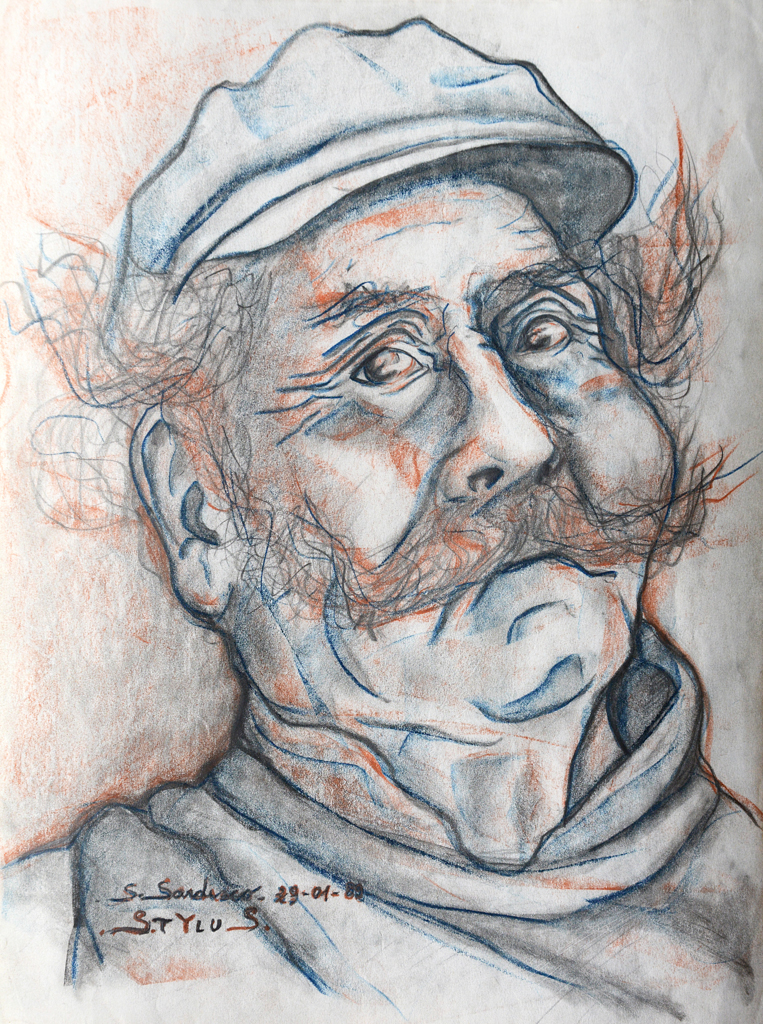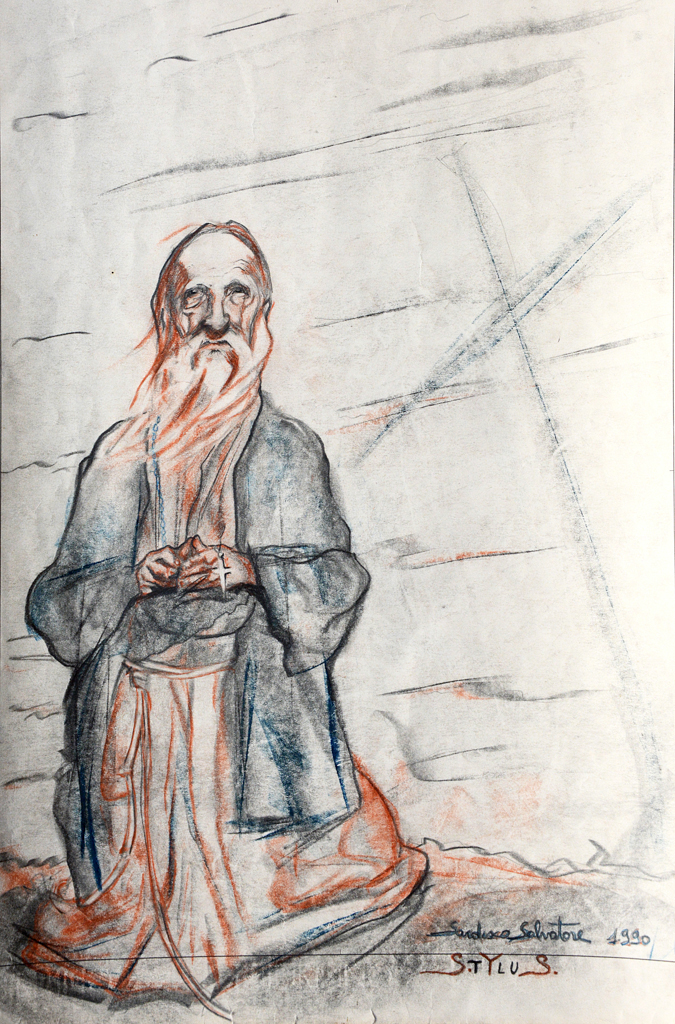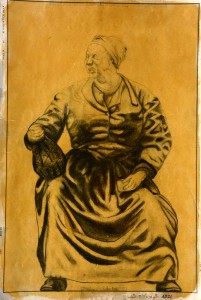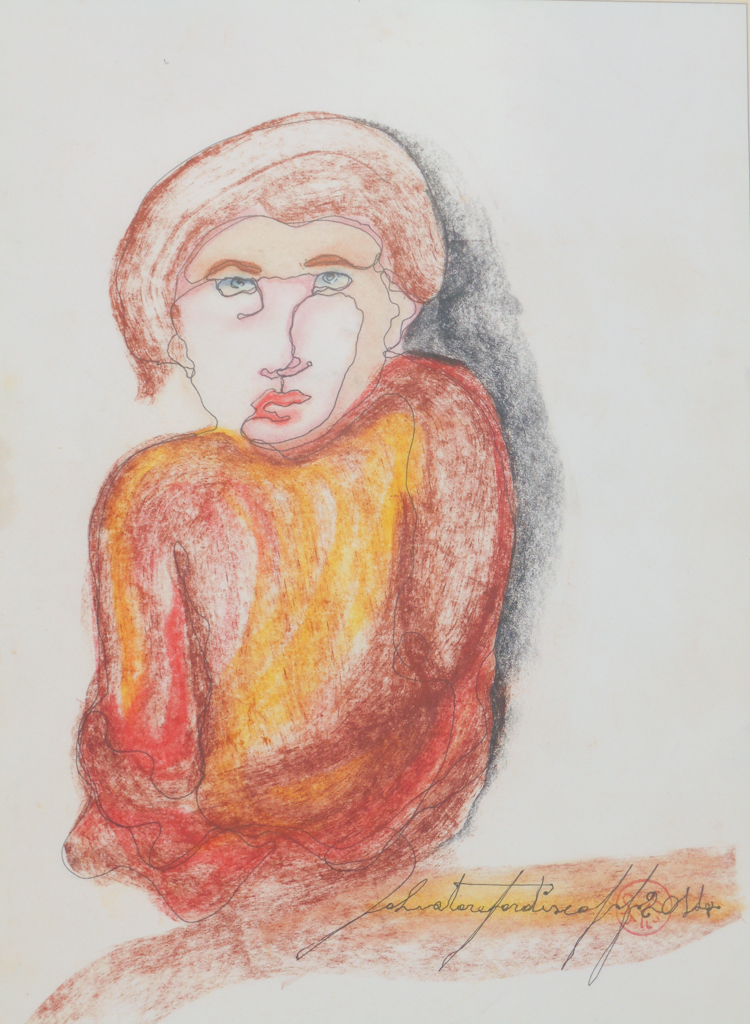04
Ritratto di bimba
1977, 24 x 30 carboncino su carta
Ispirato ad un realismo senza tempo, è l’immagine stessa della purezza ed ingenuità.
Da notare la centralità dello sguardo nel quale curiosità e innocenza si fondono.
This painting is inspired to a realism without time, it’s the image of the purity and naivety.
The focus of the look in which the curiosity and innocence are united, obviously.
09
 Speranza
Speranza
1972, 30 x 40 olio su tela
Gli olii su tela dedicati agli Indiani: un soggetto di per sé indicativo dell’appartenenza, simpatia e vicinanza del Nostro al mondo dei più deboli, degli accerchiati dalla vita, degli sconfitti. Ancora una volta si fa sentire il peso che ha su StYluS l’esperienza di vita vissuta… Il tema ha qui due varianti. L’una è la speranza colta nella sua intensità e quasi trepidazione, apprensione: una speranza sofferta eppure limpida e innocente come è negli ultimi.
The oil paintings on canvan are dedicated to the Indians: an indicative subject of the affiliation, the affection and the proximity to the wikest world, to the surrounded by the life and of the loser. Once more it makes him feel the weight that has on StYluS the experience of lived life… The theme has two variations: the hope with it’s intensity and almost trepidation, apprehension: a suffered hope but clear and innocent like in the last man in the society.
06
 Donna senza tempo
Donna senza tempo
1973, 67.5 x 60 carboncino su carta
Volto immaginario, di una donna che non ha età e in un atteggiamento ancora una volta enigmatico del femmineo di StYluS: la donna madre che è vita ma anche mistero.
Imaginary face of a woman without age and in an enigmatic attitude of the StYluS’s feminine one: the mother who is life but mystery, too
20

L’Infanzia del vecchio
1989, 31.5 x 24, carboncino sanguigno misto su carta
Ritratto di persona realmente esistita. Uomo alla veneranda età, ricorda l’Autore, di novantotto anni compiuti. Di qui come il compiacimento di una straordinaria vitalità e
consapevolezza della vita, che emana dal volto dell’anziano, raffigurato in pochi tratti.
20

Il Lavoratore
1989, 31.5 x 24 carboncino sanguigno misto su carta
Opera istintiva, prorompente a bene rappresentare la fierezza e l’orgoglio del mondo umile, ma attivo del lavoro. La figura, avvolta da una grande luce, ci restituisce la semplicità, la trasparenza dell’animo e la dignità composta di chi opera concretamente e quotidianamente.
Instinctive painting that represent the boldness and the pride of the humble, but active world of the job. The figure, sorrounded by a great light, gives us the simplicity, the transparency of the soul and the dignity of who works concretely and daily.
20
20
Il Mendicante
1990, 32.5 x 48 carboncino e sanguigno misto su carta
Lavoro di fantasia e di studio che, nelle espresse intenzioni dell’artista, diventerà a breve un dipinto ad olio a grandezza naturale.
In realtà è una bellissima opera in sè compiuta con la capacità di restituirci la dignità umana sofferente.
La potenza espressiva, che richiama Michelangelo Buonarroti, si mostra a pieno con un uso del colore sanguigno misto, davvero suggestivo.
Il mendicante è lì su di un lastricato, in una piazza che è il mondo, e lasciato solo, inchinato davanti ad un sacco di iuta e con in mano un rosario e qualche spicciolo.
La sua grandezza è quella stessa dell’uomo umile e povero che medita sulle sue e nostre miserie e non solo materiali, e non chiede solo denari, ma compassione,affetto.
In lui, infine, si riconoscono i tratti di un che di sovrannaturale e divino.
L’amore e la sensibilità con la quale viene alla luce questa immagine quasi religiosa è emblema della visione del mondo, della weltanchaung dell’artista: l’uomo è e rimane
al centro della storia e in ognuno si cela la forza e la dignità che ci rende simili agli altri e a Dio.
Meraviglioso messaggio.
Painting of imagination and study that will become – in the express intentions of the artist – an oil painting at full scale.
In reality it’s beautiful in itself finished with the ability to return us the suffering human dignity.
The expressive power, remembering Michelangelo Buonarroti, appears totaly with an use of the mixed blood color, indeed suggestive.
The mendicant is on pavingstone in a square that is the world and alone before a jute sack, with a rosary handly and few cents.
Its greatness is that same of the humble and poor man that meditates on his and our poverties and not only material; he doesn’t ask only money but compassion and affection.
Somentings of sovrannaturale and divine is in his lines.
26

L’Eremita
1990, 32.5 x 48 carboncino sanguigno misto su carta
Disegno di grande effetto e con “momenti suggestivi”, a partire dallo sguardo compito, pieno di saggezza e consapevolezza. “La cornice” è una parete rocciosa che sovrasta, come il destino, l’uomo che, al contempo, ha emblematicamente davanti a sè, il riflesso della Croce.
L’opera ci offre da un lato un evidente senso di movimento, dato dal vento che agisce su più direzioni sull’eremita, dall’altro la dedizione di questi alla preghiera, la sua imperturbabile meditazione.
A great effect and some suggestive moments in this drawing, from the performed look full of wisdom and awareness. A “frame” is a rocky wall that overhangs the man (as the destiny) who has the reflex of the Cross ahead of him.
This work offers us an evident sense of movement by the wind that acts from more directions on the hermit and the devotion to the prayer, in his imperturbable meditation.
12
L’Adolescenza
2014, 30 x 42, biro e carboncino misto e sanguigno
L’adolescenza è colta in quello stadio di intima contraddizione fra il desiderio di crescere e apparire già donne e il corpo ancora informe di un’età ancora non lontana dalla pubertà. Gli occhi pudici e puri di chi non conosce le malizie della vita e l’atteggiamento accolto e quasi indifeso in attesa di un futuro, di cui non si conoscono neppure i contorni, convivono qui con la cura dei capelli e la labbra colorate di rossetto: piccoli elementi a descrivere, con semplicità e ricchezza artistica originali, l’enigma di quel tempo della nostra vita, nel quale timori e speranze, illusioni e attese coesistono. L’opera è una felice espressione del ritorno di StYluS al linearismo continuo.
In a stadium of intimate contradiction, among the desire to grow and to appear not still already women and the shapeless body of an age distant from the puberty, adolescence is taken here. The modest and pure eyes of whom doesn’t know the spites of the life and the helpless attitude waiting for a future without contours; in this painting they cohabit with the care of the hair and with colored lips by lipstick. They are small elements which describe, with simplicity and original artistic wealth, the enigma of that time of our life in which fears and hopes, illusions and waits coexist. This painting is a happy expression of the return of StYluS to the continuous line.





